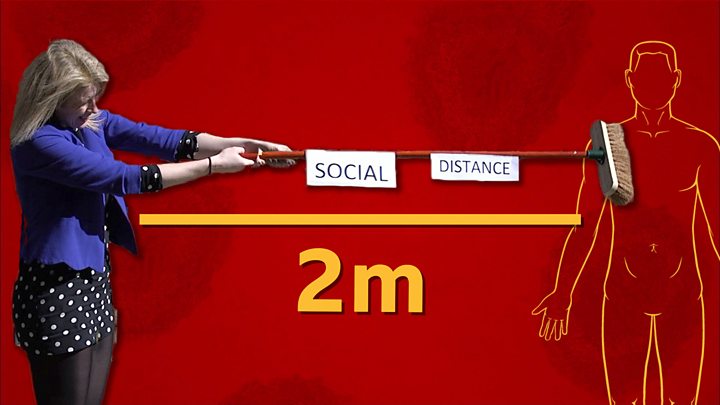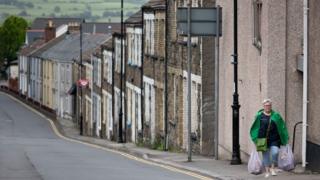
 Image copyright
Image copyright
Getty Images
A review into the 2m (6ft) social distancing rule has been commissioned by UK Prime Minister Boris Johnson.
He faces increasing pressure from his own MPs and the hospitality industry to allow people to be closer together, to help businesses after they reopen.
However, the government’s scientific advisers say that being 1m (just over 3ft) apart carries up to 10 times the risk of being 2m apart.
What does the science say?
The simple answer is that the nearer you are to someone who is infected, the greater the risk of catching the virus.
The World Health Organization recommends keeping a distance of at least 1m.
Some countries have adopted this guidance, often because they also insist on people wearing masks.
Others, including the UK, have gone further:
- 1m distancing rule – China, Denmark, France, Hong Kong, Lithuania, Singapore
- 1.4m – South Korea
- 1.5m – Australia, Belgium, Germany, Greece, Italy, Netherlands, Portugal
- 1.8m – US
- 2m – Canada, Spain, UK

Media playback is unsupported on your device
What’s the latest research?
In a study published in medical journal The Lancet, scientists looked at research into how coronavirus spreads.
They concluded that keeping at least 1m from other people could be the best way to limit the chances of infection.
The risk of being infected is estimated to be 13% within 1m, but only 3% beyond that distance.
And the study says that for every extra metre of distance up to 3m, the risk is further reduced by half.
Where does the distancing rule come from?
It can be traced back to research in the 1930s.
Scientists found that droplets of liquid released by coughs or sneezes evaporate quickly in the air or fall to the ground.
Most of those droplets, they reckoned, would land within 1-2m.
That is why it is said the greatest risks come from having the virus coughed at you from close range, or from touching a surface that someone coughed onto, and then touching your face.
Image copyright
Getty Images
Can the virus travel further in other ways?
Proximity and surface contact are considered the main transmission routes.
But some researchers fear coronavirus can also be transported through the air in tiny particles called aerosols.
If true, then the flow of wind from someone’s breath could carry the virus over longer distances.
Prof Lydia Bourouiba from the Massachusetts Institute of Technology (MIT) used high-speed cameras to capture a cough projecting miniature specks as far as 6m.
And a study carried out in Chinese hospitals which found traces of coronavirus in Covid-19 wards and intensive care units, estimated that 4m was a better safe distance.
But the US Centers for Disease Control says the role of aerosols in spreading the virus is “currently uncertain”.
And what’s still not known is whether any virus that spreads further than 2m can still be infectious.
- Coronavirus: Can we stay safe as lockdown eases?
It’s not just about distance
Timing is also key. The longer you spend in close proximity with an infected person, the bigger the risk.
Scientists advising the UK government say spending six seconds at a distance of 1m from someone is the same as spending one minute at a distance of 2m.
Being exposed to someone coughing is riskier. Being 2m away from a cough carries the same risk as someone talking to you for 30 minutes at the same distance.
The quality of ventilation also matters
A crowded stuffy room is bound to increase the chances of infection.
The direction of air flow is also crucial – whether a draught or fan behind someone infected is pushing any virus they breathe out towards you.
And a good supply of fresh air can make all the difference.
In a restaurant in China, where nine people caught the virus, the air conditioning units mounted on the walls were blamed for recirculating the air rather than refreshing it.
Japanese researchers investigated 110 cases of Covid-19 and found the odds of infection were nearly 19 times greater indoors than outside.
What else makes a difference?
Scientists advising the British government say every workplace or building should assess the risks.
And they say where 2m of social distancing is impossible, people should only be closer for short periods of time.
Plastic screens are suggested along with moving to shift patterns of work to minimise the numbers in at any one time.
Arranging seating so people are not face to face is also judged to help.
And in a growing number of many countries, including all parts of the UK, people are being encouraged to wear face coverings on public transport and “enclosed spaces where social distancing is not always possible”.
Image copyright
Reuters
Why don’t we have definite answers?
It is only a few months since the coronavirus emerged, and in that short time scientists have learned a great deal about it.
But we still don’t know how much virus can be released by people who are infected and how much someone has to receive to catch the disease.
Until that is established, the advice is that the risks are real – and that only when the numbers being infected drop dramatically can the distancing guidance be relaxed.
Source link


